Abstract
Accidents are the most common cause of death in children over one year of age. Prevention remains a high priority. We have reviewed the current epidemiology of childhood accidents and their prevention, and made recommendations for the future. In 1992, 559 children died in United Kingdom as a result of an accidents--240 from road traffic accidents and 100 from burns and scalds. Every year 50 children drown. Accidents cause significant disability to children. Many children, up to one in four of the population in urban areas, attend accident and emergency departments, and 5-10% of these are admitted to hospital. Accident risk factors include low social class, psychosocial stress, an unsafe environment, and child developmental disorders. Research has shown that prevention is best achieved by making the child's environment safer, often through legislation. Insufficient resources have been put into both research into childhood injuries and preventive work in communities. Collaboration between health authorities, NHS trusts, local authorities and community networks is vital if success is to be achieved. A national safety agenda for children would focus the attention that this problem deserves.
Full text
PDF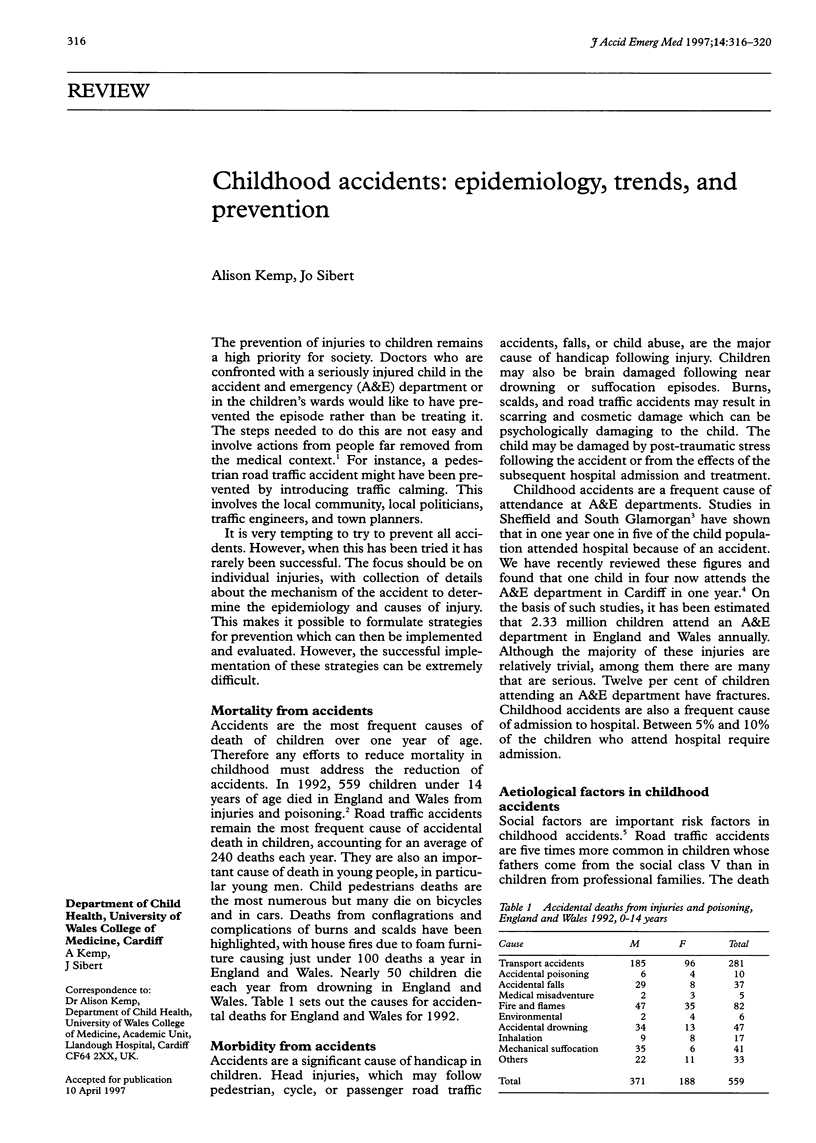
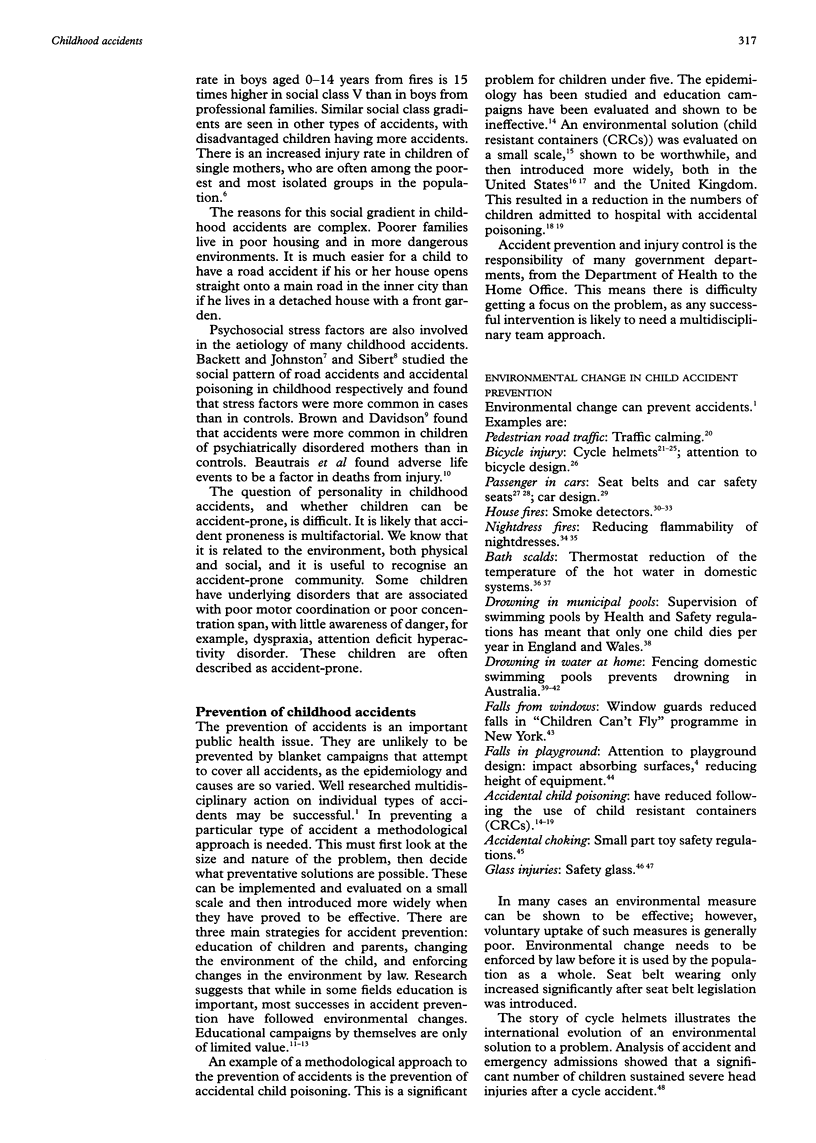
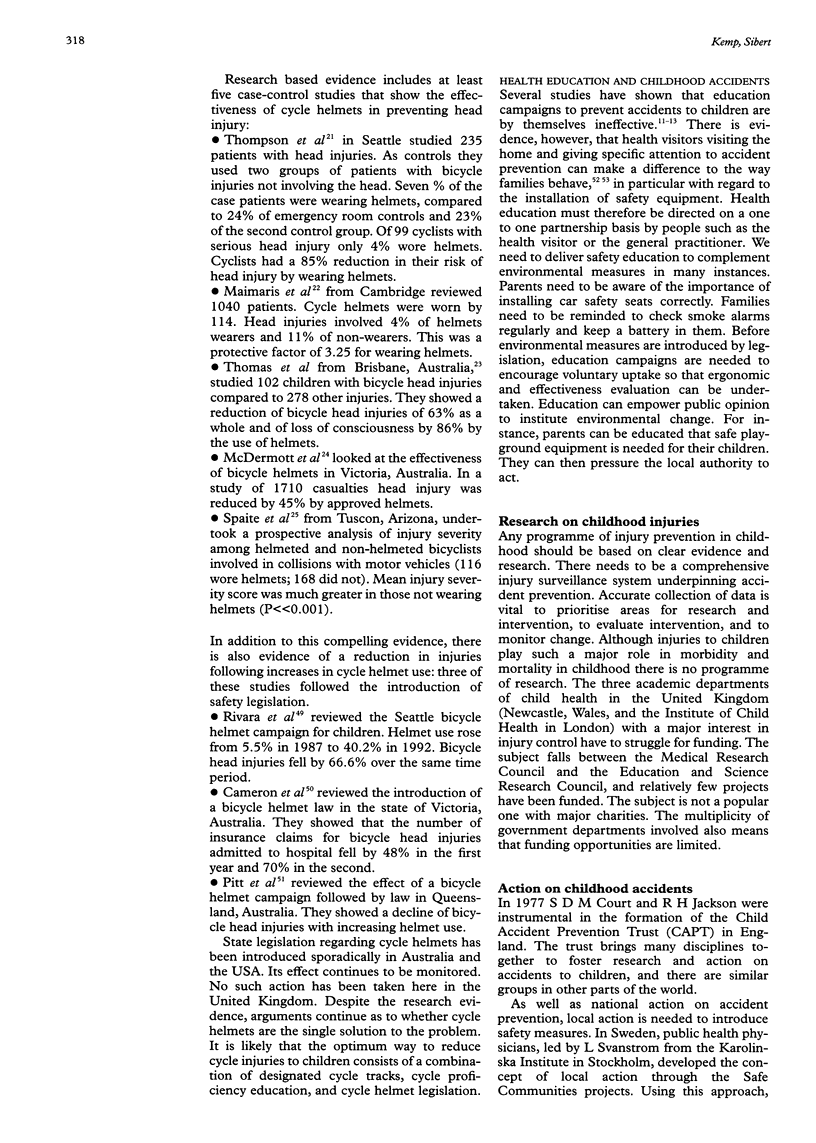
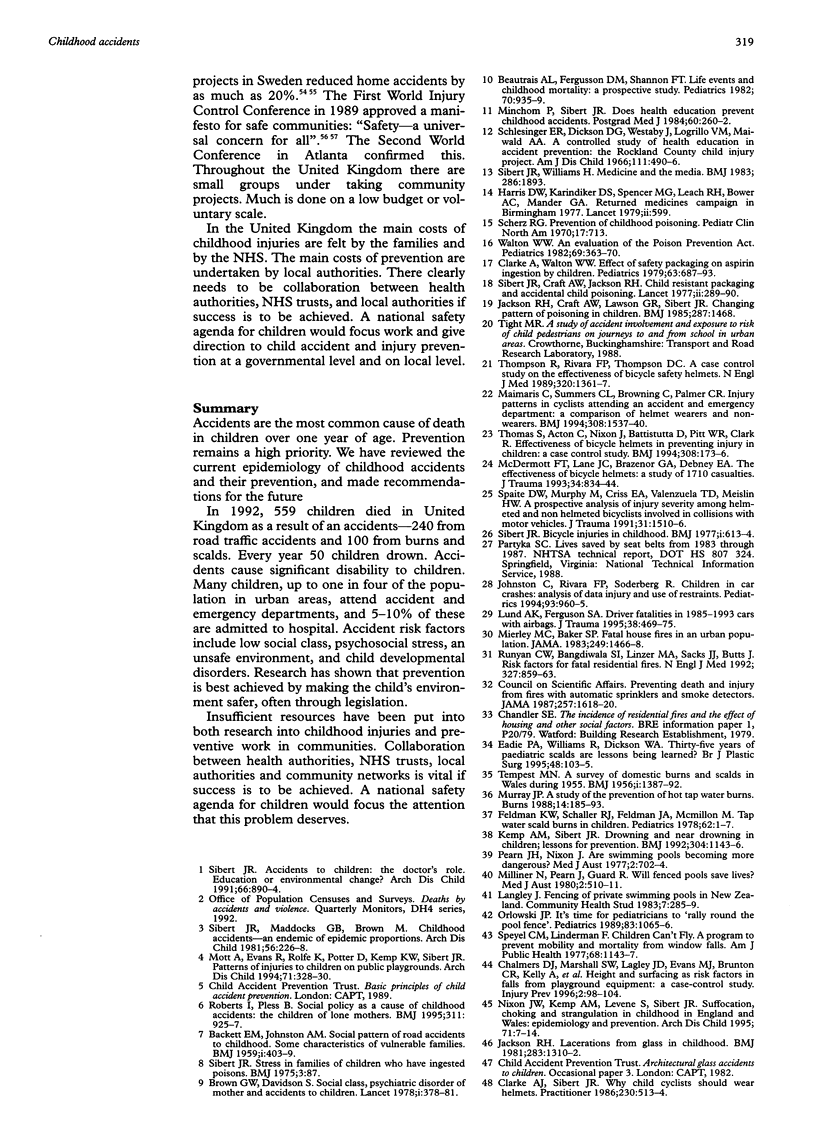
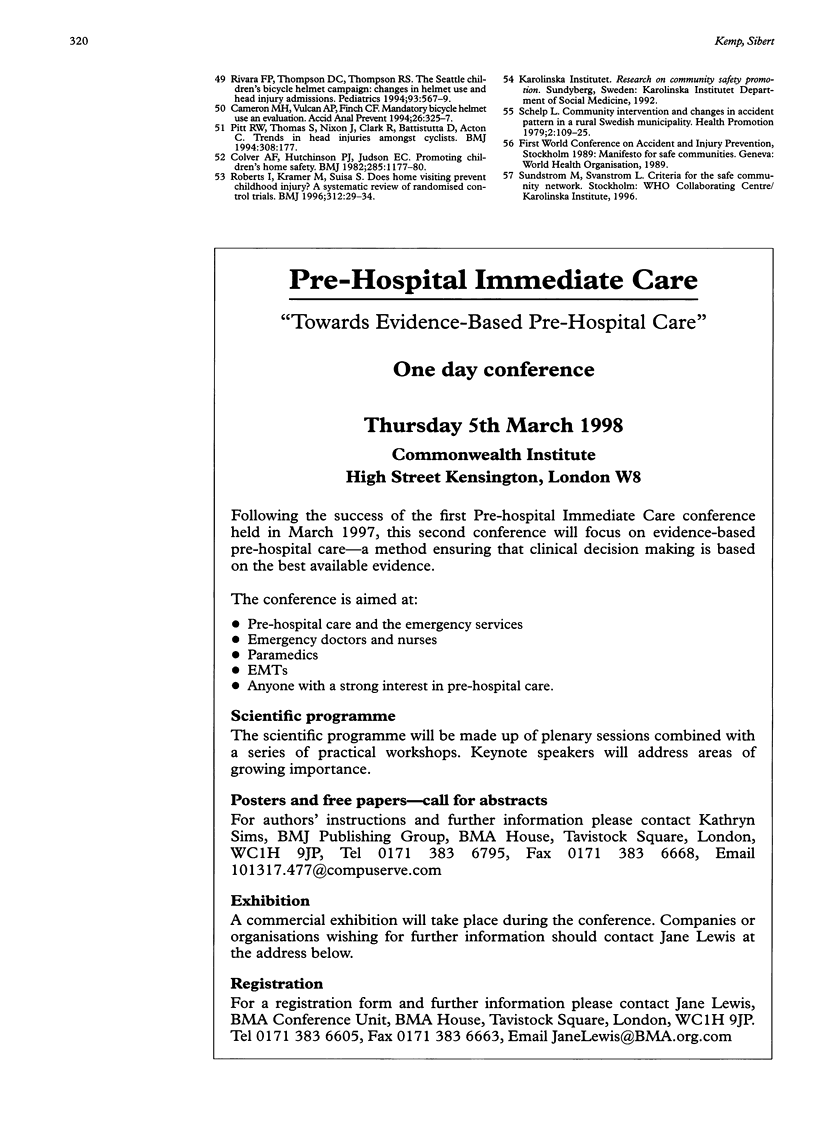
Selected References
These references are in PubMed. This may not be the complete list of references from this article.
- Beautrais A. L., Fergusson D. M., Shannon F. T. Life events and childhood morbidity: a prospective study. Pediatrics. 1982 Dec;70(6):935–940. [PubMed] [Google Scholar]
- Cameron M. H., Vulcan A. P., Finch C. F., Newstead S. V. Mandatory bicycle helmet use following a decade of helmet promotion in Victoria, Australia--an evaluation. Accid Anal Prev. 1994 Jun;26(3):325–337. doi: 10.1016/0001-4575(94)90006-x. [DOI] [PubMed] [Google Scholar]
- Chalmers D. J., Marshall S. W., Langley J. D., Evans M. J., Brunton C. R., Kelly A. M., Pickering A. F. Height and surfacing as risk factors for injury in falls from playground equipment: a case-control study. Inj Prev. 1996 Jun;2(2):98–104. doi: 10.1136/ip.2.2.98. [DOI] [PMC free article] [PubMed] [Google Scholar]
- Clarke A., Walton W. W. Effect of safety packaging on aspirin ingestion by children. Pediatrics. 1979 May;63(5):687–693. [PubMed] [Google Scholar]
- Colver A. F., Hutchinson P. J., Judson E. C. Promoting children's home safety. Br Med J (Clin Res Ed) 1982 Oct 23;285(6349):1177–1180. doi: 10.1136/bmj.285.6349.1177. [DOI] [PMC free article] [PubMed] [Google Scholar]
- Eadie P. A., Williams R., Dickson W. A. Thirty-five years of paediatric scalds: are lessons being learned? Br J Plast Surg. 1995 Mar;48(2):103–105. doi: 10.1016/0007-1226(95)90105-1. [DOI] [PubMed] [Google Scholar]
- Feldman K. W., Schaller R. T., Feldman J. A., McMillon M. Tap water scald burns in children. Pediatrics. 1978 Jul;62(1):1–7. [PubMed] [Google Scholar]
- Harris D. W., Karandikar D. S., Spencer M. G., Leach R. H., Bower A. C., Mander G. A. Returned-medicines campaign in Birmingham, 1977. Lancet. 1979 Mar 17;1(8116):599–601. doi: 10.1016/s0140-6736(79)91020-1. [DOI] [PubMed] [Google Scholar]
- Jackson R. H. Lacerations from glass in childhood. Br Med J (Clin Res Ed) 1981 Nov 14;283(6302):1310–1312. doi: 10.1136/bmj.283.6302.1310. [DOI] [PMC free article] [PubMed] [Google Scholar]
- Johnston C., Rivara F. P., Soderberg R. Children in car crashes: analysis of data for injury and use of restraints. Pediatrics. 1994 Jun;93(6 Pt 1):960–965. [PubMed] [Google Scholar]
- Kemp A., Sibert J. R. Drowning and near drowning in children in the United Kingdom: lessons for prevention. BMJ. 1992 May 2;304(6835):1143–1146. doi: 10.1136/bmj.304.6835.1143. [DOI] [PMC free article] [PubMed] [Google Scholar]
- Langley J. Fencing of private swimming pools in New Zealand. Community Health Stud. 1983 Oct;7(3):285–289. doi: 10.1111/j.1753-6405.1983.tb00060.x. [DOI] [PubMed] [Google Scholar]
- Lund A. K., Ferguson S. A. Driver fatalities in 1985-1993 cars with airbags. J Trauma. 1995 Apr;38(4):469–475. doi: 10.1097/00005373-199504000-00001. [DOI] [PubMed] [Google Scholar]
- Maimaris C., Summers C. L., Browning C., Palmer C. R. Injury patterns in cyclists attending an accident and emergency department: a comparison of helmet wearers and non-wearers. BMJ. 1994 Jun 11;308(6943):1537–1540. doi: 10.1136/bmj.308.6943.1537. [DOI] [PMC free article] [PubMed] [Google Scholar]
- McDermott F. T., Lane J. C., Brazenor G. A., Debney E. A. The effectiveness of bicyclist helmets: a study of 1710 casualties. J Trauma. 1993 Jun;34(6):834–845. doi: 10.1097/00005373-199306000-00015. [DOI] [PubMed] [Google Scholar]
- Mierley M. C., Baker S. P. Fatal house fires in an urban population. JAMA. 1983 Mar 18;249(11):1466–1468. [PubMed] [Google Scholar]
- Milliner N., Pearn J., Guard R. Will fenced pools save lives? A 10-year study from Mulgrave Shire, Queensland. Med J Aust. 1980 Nov 1;2(9):510–511. doi: 10.5694/j.1326-5377.1980.tb100717.x. [DOI] [PubMed] [Google Scholar]
- Minchom P. E., Sibert J. R., Newcombe R. G., Bowley M. A. Does health education prevent childhood accidents? Postgrad Med J. 1984 Apr;60(702):260–262. doi: 10.1136/pgmj.60.702.260. [DOI] [PMC free article] [PubMed] [Google Scholar]
- Mott A., Evans R., Rolfe K., Potter D., Kemp K. W., Sibert J. R. Patterns of injuries to children on public playgrounds. Arch Dis Child. 1994 Oct;71(4):328–330. doi: 10.1136/adc.71.4.328. [DOI] [PMC free article] [PubMed] [Google Scholar]
- Orlowski J. P. It's time for pediatricians to 'rally 'round the pool fence'. Pediatrics. 1989 Jun;83(6):1065–1066. [PubMed] [Google Scholar]
- Pearn J., Nixon J. Are swimming pools becoming more dangerous? Med J Aust. 1977 Nov 19;2(21):702–704. doi: 10.5694/j.1326-5377.1977.tb99227.x. [DOI] [PubMed] [Google Scholar]
- Pitt W. R., Thomas S., Nixon J., Clark R., Battistutta D., Acton C. Trends in head injuries among child bicyclists. BMJ. 1994 Jan 15;308(6922):177–177. doi: 10.1136/bmj.308.6922.177. [DOI] [PMC free article] [PubMed] [Google Scholar]
- Rivara F. P., Thompson D. C., Thompson R. S., Rogers L. W., Alexander B., Felix D., Bergman A. B. The Seattle children's bicycle helmet campaign: changes in helmet use and head injury admissions. Pediatrics. 1994 Apr;93(4):567–569. [PubMed] [Google Scholar]
- Roberts I., Kramer M. S., Suissa S. Does home visiting prevent childhood injury? A systematic review of randomised controlled trials. BMJ. 1996 Jan 6;312(7022):29–33. doi: 10.1136/bmj.312.7022.29. [DOI] [PMC free article] [PubMed] [Google Scholar]
- Runyan C. W., Bangdiwala S. I., Linzer M. A., Sacks J. J., Butts J. Risk factors for fatal residential fires. N Engl J Med. 1992 Sep 17;327(12):859–863. doi: 10.1056/NEJM199209173271207. [DOI] [PubMed] [Google Scholar]
- Scherz R. G. Prevention of childhood poisoning. A community project. Pediatr Clin North Am. 1970 Aug;17(3):713–727. doi: 10.1016/s0031-3955(16)32462-2. [DOI] [PubMed] [Google Scholar]
- Sibert J. R. Accidents to children: the doctor's role. Education or environmental change? Arch Dis Child. 1991 Jul;66(7):890–893. doi: 10.1136/adc.66.7.890. [DOI] [PMC free article] [PubMed] [Google Scholar]
- Sibert J. R., Craft A. W., Jackson R. H. Child-resistant packaging and accidental child poisoning. Lancet. 1977 Aug 6;2(8032):289–290. doi: 10.1016/s0140-6736(77)90966-7. [DOI] [PubMed] [Google Scholar]
- Sibert J. R., Newcombe R. G. Bicycle injuries in children. Br Med J. 1977 Mar 5;1(6061):613–614. doi: 10.1136/bmj.1.6061.613. [DOI] [PMC free article] [PubMed] [Google Scholar]
- Sibert R. Stress in families of children who have ingested poisons. Br Med J. 1975 Jul 12;3(5975):87–89. doi: 10.1136/bmj.3.5975.87. [DOI] [PMC free article] [PubMed] [Google Scholar]
- Spaite D. W., Murphy M., Criss E. A., Valenzuela T. D., Meislin H. W. A prospective analysis of injury severity among helmeted and nonhelmeted bicyclists involved in collisions with motor vehicles. J Trauma. 1991 Nov;31(11):1510–1516. doi: 10.1097/00005373-199111000-00008. [DOI] [PubMed] [Google Scholar]
- TEMPEST M. N. A survey of domestic burns and scalds in Wales during 1955; some observations on their prevention and the social responsibility of the medical profession. Br Med J. 1956 Jun 16;1(4980):1387–1392. doi: 10.1136/bmj.1.4980.1387. [DOI] [PMC free article] [PubMed] [Google Scholar]
- Thomas S., Acton C., Nixon J., Battistutta D., Pitt W. R., Clark R. Effectiveness of bicycle helmets in preventing head injury in children: case-control study. BMJ. 1994 Jan 15;308(6922):173–176. doi: 10.1136/bmj.308.6922.173. [DOI] [PMC free article] [PubMed] [Google Scholar]
- Thompson R. S., Rivara F. P., Thompson D. C. A case-control study of the effectiveness of bicycle safety helmets. N Engl J Med. 1989 May 25;320(21):1361–1367. doi: 10.1056/NEJM198905253202101. [DOI] [PubMed] [Google Scholar]
- Walton W. W. An evaluation of the Poison Prevention Packaging Act. Pediatrics. 1982 Mar;69(3):363–370. [PubMed] [Google Scholar]


